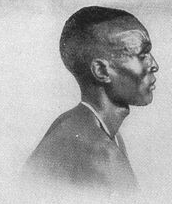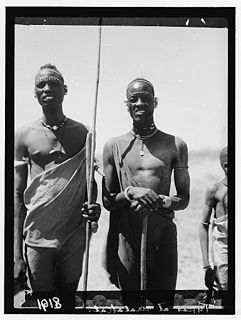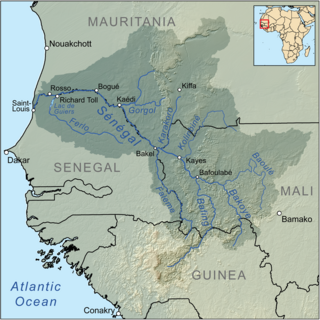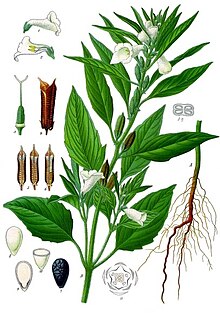
The Dinka people are a Nilotic ethnic group native to South Sudan, but also having a sizable diaspora population. They mostly live along the Nile, from Mangalla to Renk, in regions of Bahr el Ghazal, Upper Nile and Abyei Area of the Ngok Dinka in South Sudan.

The Shilluk are a major Luo Nilotic ethnic group of Southern Sudan, living on both banks of the river Nile, in the vicinity of the city of Malakal. Before the Second Sudanese Civil War the Shilluk also lived in a number of settlements on the northern bank of the Sobat River, close to where the Sobat joins the Nile.
Famine scales are the ways in which degrees of food security are measured, from situations in which an entire population has adequate food to full-scale famine. The word "famine" has highly emotive and political connotations and there has been extensive discussion among international relief agencies offering food aid as to its exact definition. For example, in 1998, although a full-scale famine had developed in southern Sudan, a disproportionate amount of donor food resources went to the Kosovo War. This ambiguity about whether or not a famine is occurring, and the lack of commonly agreed upon criteria by which to differentiate food insecurity has prompted renewed interest in offering precise definitions. As different levels of food insecurity demand different types of response, there have been various methods of famine measurement proposed to help agencies determine the appropriate response.
The famine in Sudan in 1998 was a humanitarian disaster caused mainly by human rights abuses, as well as drought and the failure of the international community to react to the famine risk with adequate speed. The worst affected area was Bahr el Ghazal in southwestern Sudan. In this region over 70,000 people died during the famine.

Doleib Hill was a mission station established by the American Inland Mission in southern Sudan, located approximately 10 miles (16 km) south of the city of Malakal, on the northern bank of the Sobat River, then in the former Upper Nile province of Sudan, the present day Upper Nile state of South Sudan.
On 3 July 2007, flash floods started to devastate many parts of Sudan, including some areas in Darfur and Southern Sudan.

A large-scale, drought-induced famine occurred in Africa's Sahel region and many parts of the neighboring Sénégal River Area from February to August 2010. It is one of many famines to have hit the region in recent times.

The Shilluk Kingdom was located along the banks of the White Nile river in modern South Sudan. Its capital and royal residence was in the town of Fashoda. According to their folk history and neighboring accounts, the kingdom was founded during the mid-fifteenth century CE by its first ruler, the demigod Nyikang. During the nineteenth century, the Shilluk were affected by military assaults from the Ottoman Empire and later British colonization in Anglo-Egyptian Sudan. The Shilluk king is currently not an independent political leader, but a traditional chieftain within the governments of South Sudan and Sudan. The current Shilluk king is His Majesty Reth Kwongo Dak Padiet who ascended to the throne in 1993.
The 2010 Nigerien floods were floods across Niger which left over 111,000 people homeless. Niger was already suffering acute food shortages following prolonged drought in the Sahel region. As of 24 August 2010, at least 6 to 8 people had died. The Niger river was pushed to its highest levels in 80 years. The floods subsequently spread along the River Niger into Nigeria, Ghana, Burkina Faso, Togo and Benin over the next few months. Later storms also brewed up in the CAR, Morocco and northern Algeria.
By January 2011 the United Nations High Commissioner for Refugees (UNHCR) estimated that there are 262,900 Sudanese refugees in Chad. The majority of them left Sudan escaping from the violence of the ongoing Darfur crisis, which began in 2003. UNHCR has given the Sudanese refugees shelter in 12 different camps situated along the Chadian-Sudanese border. The most pressing issues UNHCR has to deal with in the refugee camps in Chad are related to insecurity in the camps,, malnutrition, access to water, HIV and AIDS, and education.

South Sudan is home to around 60 indigenous ethnic groups and 80 linguistic partitions among a 2016 population of around 12 million. Historically, most ethnic groups were lacking in formal Western political institutions, with land held by the community and elders acting as problem solvers and adjudicators. Today, most ethnic groups still embrace a cattle culture in which livestock is the main measure of wealth and used for bride wealth.
The history of South Sudan comprises the history of the territory of present-day South Sudan and the peoples inhabiting the region.
Between July 2011 and mid-2012, a severe drought affected the entire East Africa region. Said to be "the worst in 60 years", the drought caused a severe food crisis across Somalia, Djibouti, Ethiopia and Kenya that threatened the livelihood of 9.5 million people. Many refugees from southern Somalia fled to neighboring Kenya and Ethiopia, where crowded, unsanitary conditions together with severe malnutrition led to a large number of deaths. Other countries in East Africa, including Sudan, South Sudan and parts of Uganda, were also affected by a food crisis.

Melut County is an administrative area in the Eastern Nile state.
Ethnic violence in South Sudan has a long history among South Sudan's varied ethnic groups. South Sudan has 64 tribes with the largest being the Dinkas, who constitute about 35% of the population and predominate in government. The second largest are the Nuers. Conflict is often aggravated among nomadic groups over the issue of cattle and grazing land and is part of the wider Sudanese nomadic conflicts.

Greater Maban is a county located in the Upper Nile State of South Sudan. The county capital is the town of Bunj. In 2017, the South Sudan government divided the county into two: North East and South West.
Since 2016, a famine has been ongoing in Yemen which started during the Yemeni Civil War. Over 17 million of Yemen's population are at risk; over 3.3 million children and pregnant or lactating women suffer from acute malnutrition. Over 100,000 of the affected children are in Al Hudaydah Governorate, with the city of Al Hudaydah worst affected area of the province. According to the Norwegian Refugee Council, the famine in Yemen will soon reach "biblical proportions". The famine is being compounded by an outbreak of cholera, which is resulting in 5,000 new cases daily. Devastation of Yemeni infrastructure, health, water and sanitation systems and facilities by Saudi-led coalition air strikes led to the spread of cholera. UNICEF says that Saudi-led coalition airstrikes are deliberately targeting water systems in Yemen.

In the early months of 2017, parts of South Sudan experienced a famine following several years of instability in the country's food supply caused by war and drought. The famine, largely focused in the northern part of the country, affected an estimated five million people. In May 2017, the famine was officially undeclared but international humanitarian agencies warned of continued severe food insecurity.

As of February 2017 a drought ravages Somalia that has left more than 6 million people, or half the country's population, facing food shortages with several water supplies becoming undrinkable due to the possibility of infection.
The Tiger Faction New Forces was a Shilluk militia that took part in the South Sudanese Civil War with the aim of reversing the division of South Sudan into 28 states in order to restore the territory of the Shilluk Kingdom per its 1956 borders. Led by Yoanis Okiech, the TFNF originally split from the Sudan People's Liberation Army (SPLA) in late October 2015 and subsequently started an insurgency against the SPLM government. In course of 2016, however, it also came into conflict with SPLM-IO rebels, leading to inter-rebel fighting which resulted in Okiech's death and the group's destruction in January 2017.














